PONTIAC G5 2007 Owners Manual
Manufacturer: PONTIAC, Model Year: 2007, Model line: G5, Model: PONTIAC G5 2007Pages: 428, PDF Size: 2.46 MB
Page 251 of 428
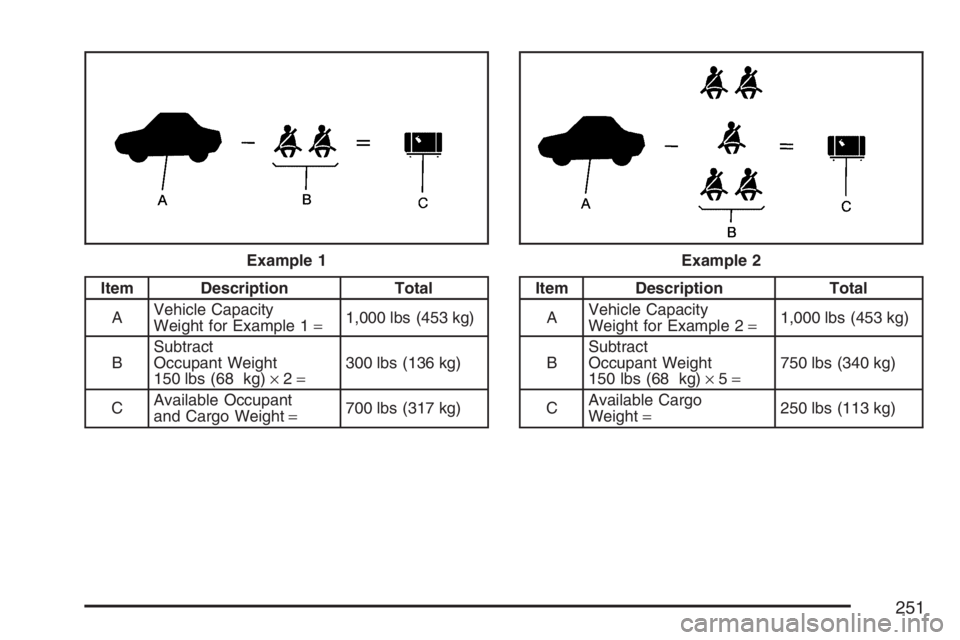
Item Description Total
AVehicle Capacity
Weight for Example 1=1,000 lbs (453 kg)
BSubtract
Occupant Weight
150 lbs (68 kg)×2=300 lbs (136 kg)
CAvailable Occupant
and Cargo Weight=700 lbs (317 kg)Item Description Total
AVehicle Capacity
Weight for Example 2=1,000 lbs (453 kg)
BSubtract
Occupant Weight
150 lbs (68 kg)×5=750 lbs (340 kg)
CAvailable Cargo
Weight=250 lbs (113 kg) Example 1
Example 2
251
Page 252 of 428
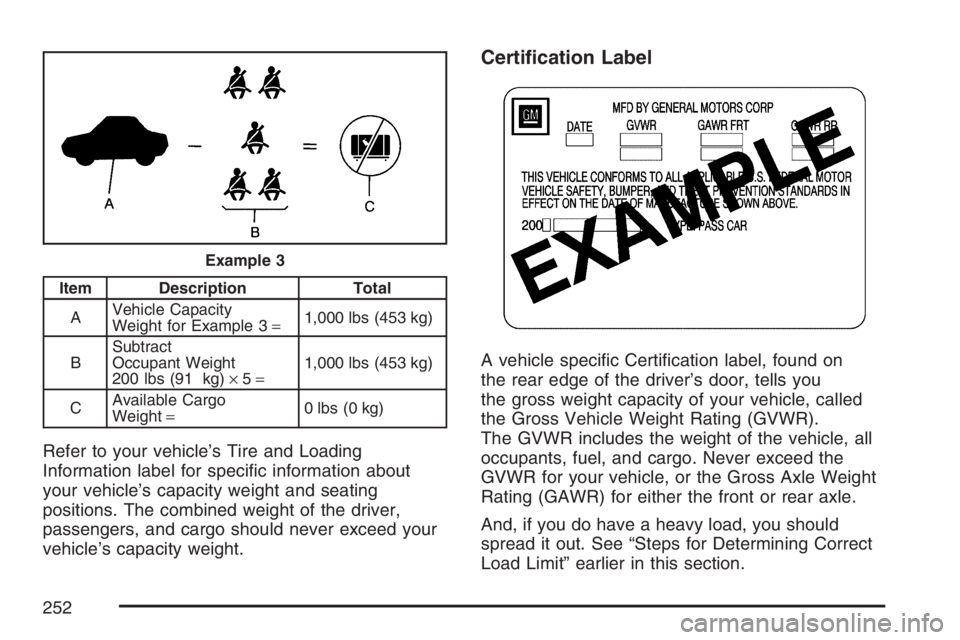
Item Description Total
AVehicle Capacity
Weight for Example 3=1,000 lbs (453 kg)
BSubtract
Occupant Weight
200 lbs (91 kg)×5=1,000 lbs (453 kg)
CAvailable Cargo
Weight=0 lbs (0 kg)
Refer to your vehicle’s Tire and Loading
Information label for speci�c information about
your vehicle’s capacity weight and seating
positions. The combined weight of the driver,
passengers, and cargo should never exceed your
vehicle’s capacity weight.
Certi�cation Label
A vehicle speci�c Certi�cation label, found on
the rear edge of the driver’s door, tells you
the gross weight capacity of your vehicle, called
the Gross Vehicle Weight Rating (GVWR).
The GVWR includes the weight of the vehicle, all
occupants, fuel, and cargo. Never exceed the
GVWR for your vehicle, or the Gross Axle Weight
Rating (GAWR) for either the front or rear axle.
And, if you do have a heavy load, you should
spread it out. See “Steps for Determining Correct
Load Limit” earlier in this section.
Example 3
252
Page 253 of 428
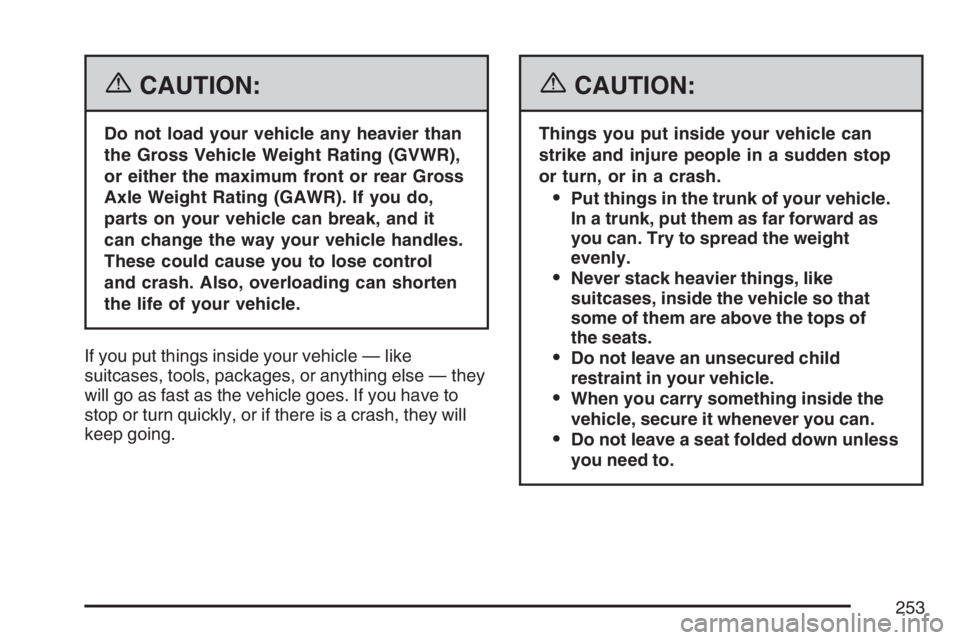
{CAUTION:
Do not load your vehicle any heavier than
the Gross Vehicle Weight Rating (GVWR),
or either the maximum front or rear Gross
Axle Weight Rating (GAWR). If you do,
parts on your vehicle can break, and it
can change the way your vehicle handles.
These could cause you to lose control
and crash. Also, overloading can shorten
the life of your vehicle.
If you put things inside your vehicle — like
suitcases, tools, packages, or anything else — they
will go as fast as the vehicle goes. If you have to
stop or turn quickly, or if there is a crash, they will
keep going.
{CAUTION:
Things you put inside your vehicle can
strike and injure people in a sudden stop
or turn, or in a crash.
Put things in the trunk of your vehicle.
In a trunk, put them as far forward as
you can. Try to spread the weight
evenly.
Never stack heavier things, like
suitcases, inside the vehicle so that
some of them are above the tops of
the seats.
Do not leave an unsecured child
restraint in your vehicle.
When you carry something inside the
vehicle, secure it whenever you can.
Do not leave a seat folded down unless
you need to.
253
Page 254 of 428
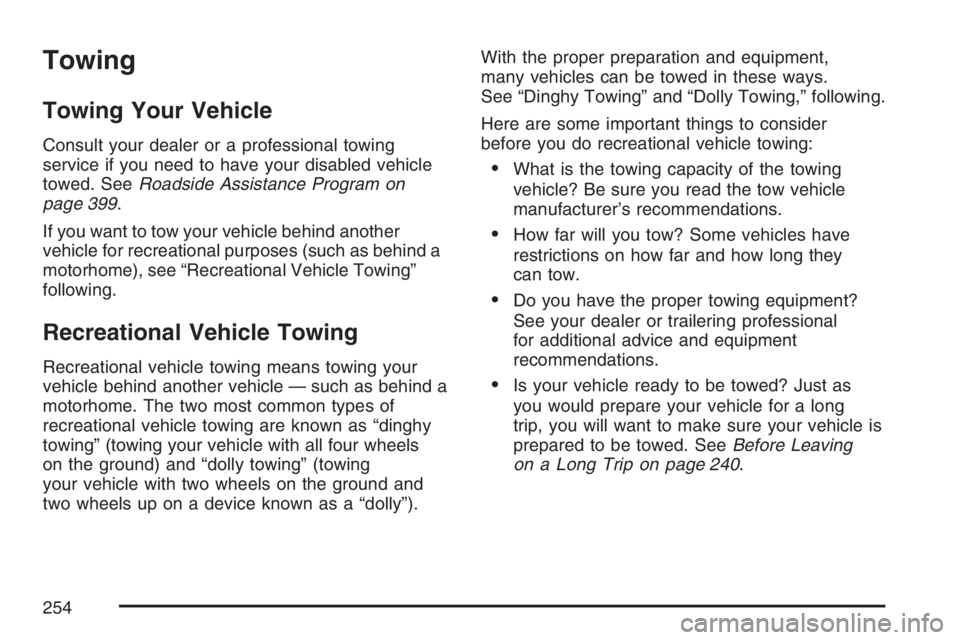
Towing
Towing Your Vehicle
Consult your dealer or a professional towing
service if you need to have your disabled vehicle
towed. SeeRoadside Assistance Program on
page 399.
If you want to tow your vehicle behind another
vehicle for recreational purposes (such as behind a
motorhome), see “Recreational Vehicle Towing”
following.
Recreational Vehicle Towing
Recreational vehicle towing means towing your
vehicle behind another vehicle — such as behind a
motorhome. The two most common types of
recreational vehicle towing are known as “dinghy
towing” (towing your vehicle with all four wheels
on the ground) and “dolly towing” (towing
your vehicle with two wheels on the ground and
two wheels up on a device known as a “dolly”).With the proper preparation and equipment,
many vehicles can be towed in these ways.
See “Dinghy Towing” and “Dolly Towing,” following.
Here are some important things to consider
before you do recreational vehicle towing:
What is the towing capacity of the towing
vehicle? Be sure you read the tow vehicle
manufacturer’s recommendations.
How far will you tow? Some vehicles have
restrictions on how far and how long they
can tow.
Do you have the proper towing equipment?
See your dealer or trailering professional
for additional advice and equipment
recommendations.
Is your vehicle ready to be towed? Just as
you would prepare your vehicle for a long
trip, you will want to make sure your vehicle is
prepared to be towed. SeeBefore Leaving
on a Long Trip on page 240.
254
Page 255 of 428

Dinghy Towing
You may dinghy tow your vehicle from the front
following these steps:
1. Set the parking brake.
2. Turn the ignition key to ACC to unlock the
steering wheel.
3. Shift an automatic transaxle to NEUTRAL (N)
or a manual transaxle to NEUTRAL.
4. Release the parking brake.To prevent the battery from draining while the
vehicle is being towed, remove the following fuse
from the �oor console fuse block: 8 (Ignition
Switch, PASS-Key
®III+). SeeFloor Console Fuse
Block on page 364for more information.
Remember to reinstall the fuse once you have
reached your destination.
Notice:If you exceed 65 mph (105 km/h) while
towing your vehicle, it could be damaged.
Never exceed 65 mph (105 km/h) while towing
your vehicle.
255
Page 256 of 428

Notice:Towing your vehicle from the rear
could damage it. Also, repairs would not
be covered by the warranty. Never have your
vehicle towed from the rear.
Dolly Towing
Your vehicle cannot be dolly towed, but can be
dinghy towed. See “Dinghy Towing” earlier in
this section.
Notice:Dolly towing your vehicle may
cause damage because of reduced ground
clearance. Always tow your vehicle using the
dinghy towing procedure listed in this
section or put your vehicle on a �atbed truck.
Towing a Trailer (Manual Transaxle)
Do not tow a trailer if your vehicle is equipped
with a manual transaxle.
256
Page 257 of 428

Towing a Trailer
(Automatic Transaxle)
{CAUTION:
If you do not use the correct equipment
and drive properly, you can lose control
when you pull a trailer. For example, if the
trailer is too heavy, the brakes may not
work well — or even at all. You and your
passengers could be seriously injured.
You may also damage your vehicle; the
resulting repairs would not be covered by
your warranty. Pull a trailer only if you have
followed all the steps in this section. Ask
your dealer for advice and information
about towing a trailer with your vehicle.Your vehicle can tow a trailer if it is equipped with
an automatic transaxle and the proper trailer towing
equipment. If your vehicle is not equipped as stated
previously, do not tow a trailer. To identify the
trailering capacity of your vehicle, you should read
the information in “Weight of the Trailer” that
appears later in this section. Trailering is different
than just driving your vehicle by itself. Trailering
means changes in handling, acceleration, braking,
durability and fuel economy. Successful, safe
trailering takes correct equipment, and it has to be
used properly.
That is the reason for this part. In it are many
time-tested, important trailering tips and safety
rules. Many of these are important for your safety
and that of your passengers. So please read
this section carefully before you pull a trailer.
Load-pulling components such as the engine,
transaxle, wheel assemblies and tires are forced
to work harder against the drag of the added
weight. The engine is required to operate
at relatively higher speeds and under greater
loads, generating extra heat. Also, the trailer adds
considerably to wind resistance, increasing the
pulling requirements.
257
Page 258 of 428

If You Do Decide To Pull A Trailer
If you do, here are some important points:
There are many different laws, including speed
limit restrictions, having to do with trailering.
Make sure your rig will be legal, not only where
you live but also where you will be driving.
A good source for this information can be state
or provincial police.
Consider using a sway control. You can ask a
hitch dealer about sway controls.
Do not tow a trailer at all during the �rst
1,000 miles (1 600 km) your new vehicle
is driven. Your engine, axle or other parts
could be damaged.
Then, during the �rst 500 miles (800 km) that
you tow a trailer, do not drive over 50 mph
(80 km/h) and do not make starts at full
throttle. This helps your engine and other parts
of your vehicle wear in at the heavier loads.
Obey speed limit restrictions when towing a
trailer. Do not drive faster than the maximum
posted speed for trailers, or no more than
55 mph (90 km/h), to save wear on your
vehicle’s parts.
Do not tow when the outside air temperature
is above 100°F (38°C).
Do not tow more than 1,000 miles (1 600 km)
per year.
Three important considerations have to do with
weight:
The weight of the trailer
The weight of the trailer tongue
The total weight on your vehicle’s tires
Weight of the Trailer
How heavy can a trailer safely be?
It should never weigh more than 1,000 lbs
(450 kg). But even that can be too heavy.
It depends on how you plan to use your rig.
For example, speed, altitude, road grades, outside
temperature and how much your vehicle is used
to pull a trailer are all important. It can also depend
on any special equipment that you have on your
vehicle, and the amount of tongue weight the
vehicle can carry. See “Weight of the Trailer
Tongue” later in this section for more information.
258
Page 259 of 428
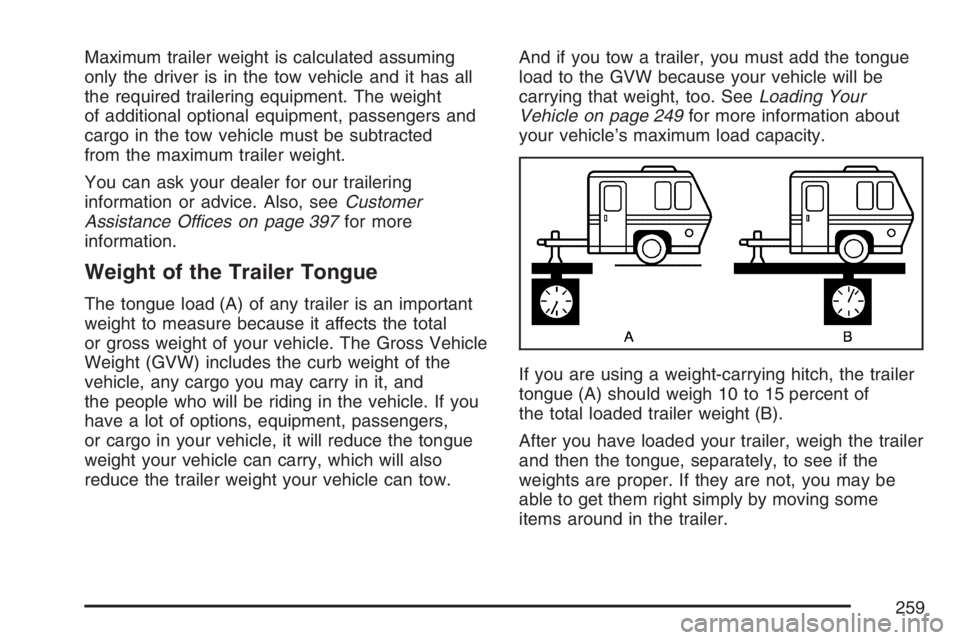
Maximum trailer weight is calculated assuming
only the driver is in the tow vehicle and it has all
the required trailering equipment. The weight
of additional optional equipment, passengers and
cargo in the tow vehicle must be subtracted
from the maximum trailer weight.
You can ask your dealer for our trailering
information or advice. Also, seeCustomer
Assistance Offices on page 397for more
information.
Weight of the Trailer Tongue
The tongue load (A) of any trailer is an important
weight to measure because it affects the total
or gross weight of your vehicle. The Gross Vehicle
Weight (GVW) includes the curb weight of the
vehicle, any cargo you may carry in it, and
the people who will be riding in the vehicle. If you
have a lot of options, equipment, passengers,
or cargo in your vehicle, it will reduce the tongue
weight your vehicle can carry, which will also
reduce the trailer weight your vehicle can tow.And if you tow a trailer, you must add the tongue
load to the GVW because your vehicle will be
carrying that weight, too. SeeLoading Your
Vehicle on page 249for more information about
your vehicle’s maximum load capacity.
If you are using a weight-carrying hitch, the trailer
tongue (A) should weigh 10 to 15 percent of
the total loaded trailer weight (B).
After you have loaded your trailer, weigh the trailer
and then the tongue, separately, to see if the
weights are proper. If they are not, you may be
able to get them right simply by moving some
items around in the trailer.
259
Page 260 of 428

Total Weight on Your Vehicle’s Tires
Be sure your vehicle’s tires are in�ated to the upper
limit for cold tires. You will �nd these numbers on
the Tire-Loading Information label. SeeLoading
Your Vehicle on page 249. Then be sure you do not
go over the GVW limit for your vehicle, including the
weight of the trailer tongue.
Hitches
It is important to have the correct hitch equipment.
Crosswinds, large trucks going by and rough
roads are a few reasons why you will need the
right hitch. Here are some rules to follow:
The rear bumper on your vehicle is not
intended for hitches. Do not attach rental
hitches or other bumper-type hitches to it.
Use only a frame-mounted hitch that does not
attach to the bumper.
Will you have to make any holes in the body
of your vehicle when you install a trailer
hitch? If you do, then be sure to seal the holes
later when you remove the hitch. If you do
not seal them, deadly carbon monoxide (CO)
from your exhaust can get into your vehicle.
SeeEngine Exhaust on page 123. Dirt and
water can also enter the vehicle.
Safety Chains
You should always attach chains between your
vehicle and your trailer. Cross the safety
chains under the tongue of the trailer so that the
tongue will not drop to the road if it becomes
separated from the hitch. Instructions about safety
chains may be provided by the hitch manufacturer
or by the trailer manufacturer. Follow the
manufacturer’s recommendation for attaching
safety chains and do not attach them to the
bumper. Always leave just enough slack so you
can turn with your rig. And, never allow safety
chains to drag on the ground.
Trailer Brakes
Does your trailer have its own brakes? Be sure to
read and follow the instructions for the trailer
brakes so you will be able to install, adjust and
maintain them properly. Do not try to tap into your
vehicle’s brake system. If you do, both brake
systems will not work well, or at all.
260